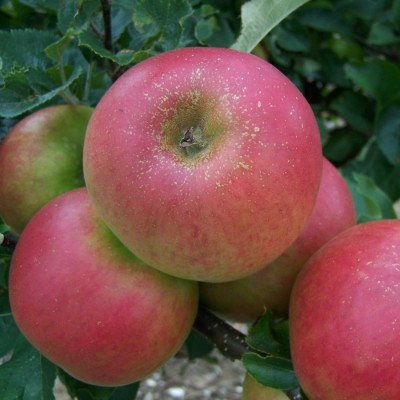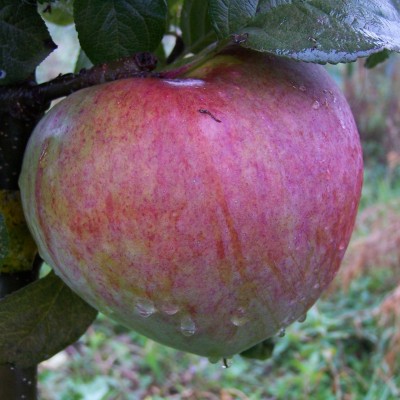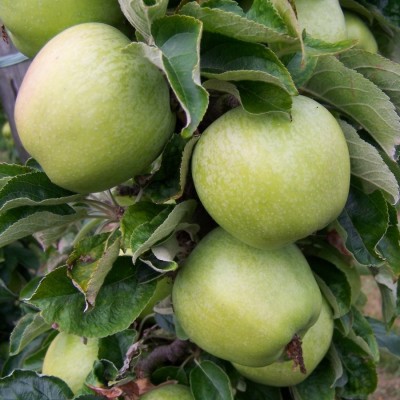If you were asked to name 5 varieties of cooking apple, the chances are that you would come up with ‘Bramley’ straight away... and then possibly struggle. However if you asked the same question a hundred years ago, you would be given a long list of names, depending on season and locality. Varieties like Greenup’s Pippin, Balsam, Lord Derby, Emperor Alexander - all were well-known, widely grown and feted for their unique cooking qualities. In this guide we will take a look at the long history of the cooking apple in the U.K., see why Bramley’s Seedling came to be the ubiquitous culinary variety and look at alternatives which deserve a space in your garden.

The commercial production of culinary apples is a uniquely British phenomenon. No other country in the world grows apples purely for cooking - everywhere else uses dessert apples. If you are wanting to cook a classic Tarte Tatin, then you need to use a desert apple such as Coxs Orange Pippin for the sweetness and to keep its shape. However for a baked apple, apple pie or the classic apple sauce accompaniment to roast pork, a cooking apple which has both a hit of acidity and cooks down to a purée is required.
Why has the U.K. such a unique history of cooking with apples? One factor is that through the Middle Ages many of the cultivated orchards fell into neglect and there was a dearth of good dessert varieties. For centuries there was also a distrust of eating raw fruit - the general consensus was that it caused ‘bad stomach’ and fever. Some physicians went as far as banning apples for children. The association of the apple as the cause of Eve’s downfall in the Bible also contributed to the lack of enthusiasm for eating the raw fruit. However cooked apples were looked on much more favourably, especially when spices were added and were eaten by all levels of society.
Another reason why the culinary apple was held in unique esteem in the U.K. is that sugar became much more readily available and cheaper, as the British sugar plantations in the West Indies became the world’s major source. Puddings and pies, flavoured with lemon peel, orange-flower water or quince were extremely popular through the 18th and 19th centuries. Baked apples were another delicacy - hollowed out and stuffed with sugar, butter and dried fruit. In Norfolk the local variety Norfolk Beefing was used to make Norfolk Biffins, so popular they would be given as gifts.
The popularity of the sour culinary apple may also be due to our climate. Apples have the ability to thrive in a wide range of temperatures, but our cooler summers do not allow as much sugar to form in the fruit. Cold winters and spring frosts meant that sweet dessert fruit such as the apricot and the peach were the preserve of the rich, who could afford to run heated greenhouses. Even many varieties of pear can be unreliable in the north of the country. The humble cooking apple, however, will grow throughout all of the U.K., and local varieties abound which thrive in even the harshest conditions. At some level, we have a tradition of cooking with apples because there were few alternatives.

There are hundreds of varieties of cooking apple in the National Collection at Brogdale in Kent, and the selection on our website will give you a choice of over fifty. So how to choose the right one for you?
The first thing to consider is storage. The reason that Bramley’s Seedling is so well-known is that is stores for a long time, until April or May if conditions are correct. It was one of the few ways of having fruit available through the winter and spring. With the advent of freezers, it is no longer necessary to store fruit - you may well prefer to pick and process the fruit in August and freeze ready made puree for later use. Even if you do wish to store fruit, the choice is a lot wider than you may think - and this is where we need to consider cooking properties.
Culinary apples have higher levels of acidity than eating apples, and it is the balance of sugar and acidity which gives the fruit it’s unique cooking properties. Generally speaking, the more acidic the fruit the more it will break down on cooking and turn into a purée. This is why a sharp Bramley will cook to a froth, whilst sweeter apples will keep their shape no matter how long they are cooked for.
If you want to make a baked apple, you need to look for an apple with a slightly lower level of acidity - varieties like Howgate Wonder and Hawthornden are excellent for this. If you prefer an apple to cook to a creamy purée, try something like Warner’s King or Dumelow's Seedling.
Be aware that the level of acidity will change from season to season and depend on the where you are growing the fruit. In warm years, or if you live in the South, fruit will generally have higher sugar levels, which is why some varieties which are feted in Scotland can taste bland and insipid if grown in warmer climes. Give cooking apples a less favourable site in part or even full-shade to get the best flavour and cooking properties.

Recommended varieties.
Bramleys Seedling.
Probably needs no introduction, as the most famous and widely grown of all culinary varieties. Raised in Southwell, Nottingham in the early 1800’s from a pip, this variety has become the standard bearer by which all other cooking apples are judged. It stores extremely well, and keeps its acidity in storage, so cooks to a fine fluff with a delicate tang. It does, however, have its drawbacks - it’s an extremely vigorous variety, so needs regular pruning to keep in check. The blossom can suffer in spring frosts and the fruit can be susceptible to scab especially if grown in the west of the U.K. Buy Apple 'Bramley's Seedling'.
Grenadier.
Probably the best of the early season cookers. Extremely reliable, this sets heavy crops of bright green fruit year after year, no matter the weather. The tree is quite compact and the fruit is tangy and cooks to a honey-flavoured purée. Crops in late August, the fruit will not store for long but is ideal for processing and freezing. Buy Apple 'Grenadier'.
James Grieve.
The classic mid-season dual purpose apple. Raised in Edinburgh and first recorded in 1893, this is an excellent choice for growing in the North of the U.K., where it will keep its delicate balance of sweetness and acidity. If grown in the south, it can become a little too sweet too cook well and will not cook to a puree. Buy Apple 'James Grieve'.
Greenup’s Pippin.
Also known as Yorkshire Beauty and for good reason - the large yellow fruit develop a wonderful orange blush as they ripen. Originally found in the garden of a shoemaker in Keswick, it was introduced by a nurseryman in the late 1700’s and was widely grown throughout much of Cumbria, Lancashire and Yorkshire. Excellent levels of acidity means it cooks to a beautiful soft puree, brisk but not needing much sugar and with a hint of lemon. Makes an absolutely wonderful apple sauce. Buy Apple 'Greenup's Pippin'.
Howgate Wonder.
An excellent alternative to Bramley - huge red flushed fruit are produced in early October which will keep well until the following spring. Hardy and good for the north of the U.K., but like Bramley it is a vigorous variety so not ideal if space is tight. Makes a wonderful baked apple. Buy Apple 'Howgate Wonder'.
Wolf River.
An American variety, first recorded in 1875 in Wisconsin. If you were thinking of putting some apples into your local village show, this is the variety for you - they are huge! Beautiful light green fruit which are flushed with a purple red. Cooks nicely, but keeps its shape. Buy Apple 'Wolf River'.
Lord Derby.
A fantastic variety which deserves wider recognition. Introduced in 1862 by a Cheshire nurseryman, this has all the cooking attributes of Bramley’s Seedling but with none of the drawbacks. Trees are hardy and disease-resistant and thrive in damp soils. It crops heavily year after year and is also reliably self-fertile. It will store past Christmas. Highly recommended. Buy Apple 'Lord Derby'.


